In the expansive skies of Africa, a realm dominated by formidable hunters, the presence of Birds of Prey paints a vivid portrait of the continent’s untamed grandeur.
From the iconic African Fish Eagle to the powerful Martial Eagle, these avian predators embody the essence of wild majesty, soaring above diverse landscapes that range from savannas to dense forests.
In this awe-inspiring realm, the question arises: What defines the Birds of Prey in Africa, and what tales do they tell of survival and significance in this vast and varied habitat?
Africa’s Birds of Prey, with their keen eyesight, powerful talons, and majestic flight, play pivotal roles in shaping the continent’s ecological balance.
As apex predators, they not only contribute to the regulation of prey populations but also symbolize the dynamic forces at play in the natural world.
Join us on a soaring expedition as we unravel the mysteries behind the predatory elegance of Africa’s Raptors, exploring their diverse species, and the vital roles they play in maintaining the harmony of the African wilderness.
25 Birds of Prey in Africa
Let’s start a journey through the soaring realms of Africa’s skies, where each species narrates a captivating tale of survival, adaptation, and the enduring symbiosis between predator and prey in this extraordinary continent.
1. Kites
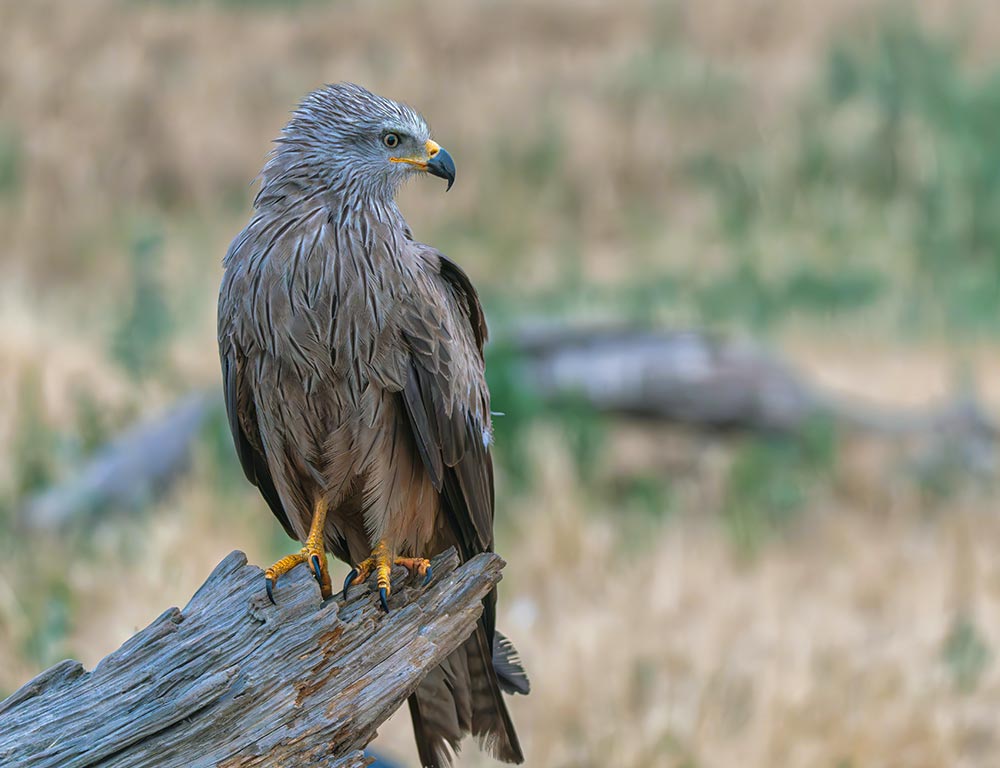
- Scientific name: Milvus spp. (e.g., Milvus migrans – Black Kite)
- Category: Bird of Prey
- Life span: 15-20 years
- Size: 55-60 cm
- Weight: 800-1,200 g
- Food: Carnivorous (scavengers, small mammals, birds, insects)
- Population: Varies among species
Kites, exemplified by the Black Kite, are adaptable raptors often seen soaring effortlessly in African skies. With a life span of 15-20 years, these birds exhibit a scavenging lifestyle, feasting on carrion, small mammals, and birds.
Their impressive wingspans and aerial agility make them adept at both hunting and scavenging.
Their populations vary among species, with some facing threats from habitat loss and poisoning. Kites play vital roles in ecosystems by helping control pest populations and participating in the natural recycling of animal carcasses.
2. Snake Eagles

- Scientific name: Circaetus spp. (e.g., Circaetus cinereus – Brown Snake Eagle)
- Category: Bird of Prey
- Life span: 15-20 years
- Size: 63-75 cm
- Weight: 1,300-2,200 g
- Food: Carnivorous (snakes, small mammals, birds)
- Population: Varies among species
The Brown Snake Eagle, a representative of this category, is an adept serpent hunter. With a life span of 15-20 years, these raptors showcase exceptional predatory skills, preying on snakes, small mammals, and birds.
Their powerful talons and keen eyesight contribute to successful hunts. Snake eagles often soar high in search of prey, using their agility to navigate through vegetation.
While some species face threats due to habitat degradation and human activities, others maintain stable populations, underscoring their crucial role in controlling snake populations and maintaining ecosystem balance.
3. African Cuckoo-Hawk

- Scientific name: Aviceda cuculoides
- Category: Bird of Prey
- Life span: 10-15 years
- Size: 35-45 cm
- Weight: 300-500 g
- Food: Carnivorous (birds, insects, small mammals)
- Population: Stable
The African Cuckoo-Hawk, characterized by its slender form, is a bird of prey found in African woodlands.
With a life span of 10-15 years, they feed on birds, insects, and small mammals. Their agile flight and quick maneuvers enable them to catch prey in dense vegetation.
With a stable population, these hawks contribute to the control of insect and small mammal populations, showcasing their ecological significance in maintaining the health of their habitats.
4. African Fish Eagle

- Scientific name: Haliaeetus vocifer
- Category: Bird of Prey
- Life span: 15-20 years
- Size: 63-75 cm
- Weight: 2.5-3.5 kg
- Food: Carnivorous (fish, birds, small mammals)
- Population: Stable
The iconic African Fish Eagle, with its distinctive call, is a symbol of African waterways. With a life span of 15-20 years, they specialize in catching fish from lakes and rivers.
Their powerful talons and keen eyesight make them efficient hunters. Fish eagles are known for their spectacular dives to seize fish near the water’s surface.
With a stable population, these eagles play a crucial role in regulating fish populations and contribute to the ecological balance of their aquatic habitats.
Their majestic presence and hunting prowess make them both a cultural and ecological cornerstone in the regions they inhabit.
5. Bearded Vulture

- Scientific name: Gypaetus barbatus
- Category: Bird of Prey
- Life span: Up to 45 years
- Size: 94-125 cm
- Weight: 4.5-7 kg
- Food: Primarily scavenger (bone-eating), occasionally small animals
- Population: Vulnerable
The Bearded Vulture, also known as the Lammergeier, is a remarkable raptor with a distinctive appearance. With a life span of up to 45 years, they primarily feed on bones, dropping them from heights to access the marrow.
This unique dietary specialization contributes to their role as nature’s cleanup crew.
Bearded Vultures inhabit mountainous regions, utilizing updrafts for soaring flight. Despite their ecological importance, their population is vulnerable due to habitat loss, poisoning, and disturbance.
Conservation efforts aim to protect their mountainous habitats and mitigate human-wildlife conflicts to ensure the survival of this magnificent vulture.
6. Bateleur

- Scientific name: Terathopius ecaudatus
- Category: Bird of Prey
- Life span: Up to 25 years
- Size: 55-70 cm
- Weight: 1.8-2.8 kg
- Food: Carnivorous (small mammals, birds, reptiles)
- Population: Decreasing
The Bateleur, with its striking black, white, and red plumage, is a medium-sized eagle. With a life span of up to 25 years, they exhibit acrobatic flight and are known for their distinctive tilting behavior in flight.
Bateleurs primarily feed on small mammals, birds, and reptiles. Unfortunately, their population is decreasing due to habitat loss, poisoning, and illegal trade.
Conservation efforts focus on protecting their habitats, combating wildlife trade, and mitigating threats to ensure the survival of this charismatic bird of prey.
7. Cape Vulture

- Scientific name: Gyps coprotheres
- Category: Bird of Prey
- Life span: Up to 30 years
- Size: 95-110 cm
- Weight: 8-9 kg
- Food: Carrion (scavenger)
- Population: Endangered
The Cape Vulture, a large scavenger, plays a crucial role in maintaining ecological balance. With a life span of up to 30 years, they primarily feed on carrion.
Their population is endangered, facing threats such as poisoning, habitat loss, and collisions with power lines.
Conservation efforts focus on creating safe feeding sites, addressing poisoning incidents, and raising awareness to ensure the survival of this vital vulture species.
8. Black Harrier

- Scientific name: Circus Maurus
- Category: Bird of Prey
- Life span: Up to 12 years
- Size: 45-55 cm
- Weight: 300-450 g
- Food: Carnivorous (small mammals, birds)
- Population: Vulnerable
The Black Harrier, a distinctive raptor endemic to southern Africa, faces conservation challenges. With a life span of up to 12 years, they primarily feed on small mammals and birds.
Their population is vulnerable due to habitat loss, agricultural practices, and human disturbance.
Conservation efforts target the protection of their coastal and fynbos habitats, emphasizing sustainable land use practices and mitigating threats to ensure the survival of this vulnerable bird of prey.
9. Peregrine Falcon

- Scientific name: Falco peregrinus
- Category: Bird of Prey
- Life span: 8-15 years
- Size: 34-50 cm
- Weight: 0.3-1.5 kg
- Food: Carnivorous (primarily birds)
- Population: Stable
The Peregrine Falcon, known for its remarkable speed and aerial prowess, is a global raptor with a life span of 8-15 years. Their diet mainly consists of birds, and they are renowned for their high-speed dives to capture prey mid-air.
Peregrine Falcons often inhabit cliffs and urban areas, utilizing their adaptability to various environments.
With a stable population, they showcase the successful recovery from past pesticide-related declines. Conservation efforts continue to monitor urban nesting sites and mitigate potential threats to maintain the stability of this iconic falcon species.
10. Secretarybird

- Scientific name: Sagittarius serpentarius
- Category: Bird of Prey
- Life span: Up to 15 years
- Size: 1.3-1.4 m
- Weight: 2.3-4.6 kg
- Food: Carnivorous (small mammals, snakes, birds)
- Population: Stable
The Secretarybird, with its distinct appearance and long legs, is a terrestrial bird of prey. With a life span of up to 15 years, they primarily feed on small mammals, snakes, and birds, using their strong legs to stamp on and capture prey.
Secretarybirds inhabit open grasslands and savannas. Their stable population reflects their adaptability to diverse habitats, though they face threats from habitat loss and human activities.
Conservation efforts focus on preserving their grassland habitats and mitigating potential conflicts to ensure the continued stability of this unique and iconic bird.
11. African Marsh Harrier

- Scientific name: Circus ranivorus
- Category: Bird of Prey
- Life span: Up to 10 years
- Size: 48-56 cm
- Weight: 0.5-1 kg
- Food: Carnivorous (small mammals, birds, insects)
- Population: Stable
The African Marsh Harrier, a medium-sized raptor, thrives in wetland habitats. With a life span of up to 10 years, they prey on small mammals, birds, and insects.
Their distinctive hunting behavior includes low flights over reed beds and marshes. Despite facing threats such as habitat loss and disturbance, their population remains stable.
Conservation efforts aim to safeguard wetland habitats, reduce human disturbance, and ensure sustainable water management to maintain the stability of this marsh-dwelling harrier.
12. Giant Eagle Owl
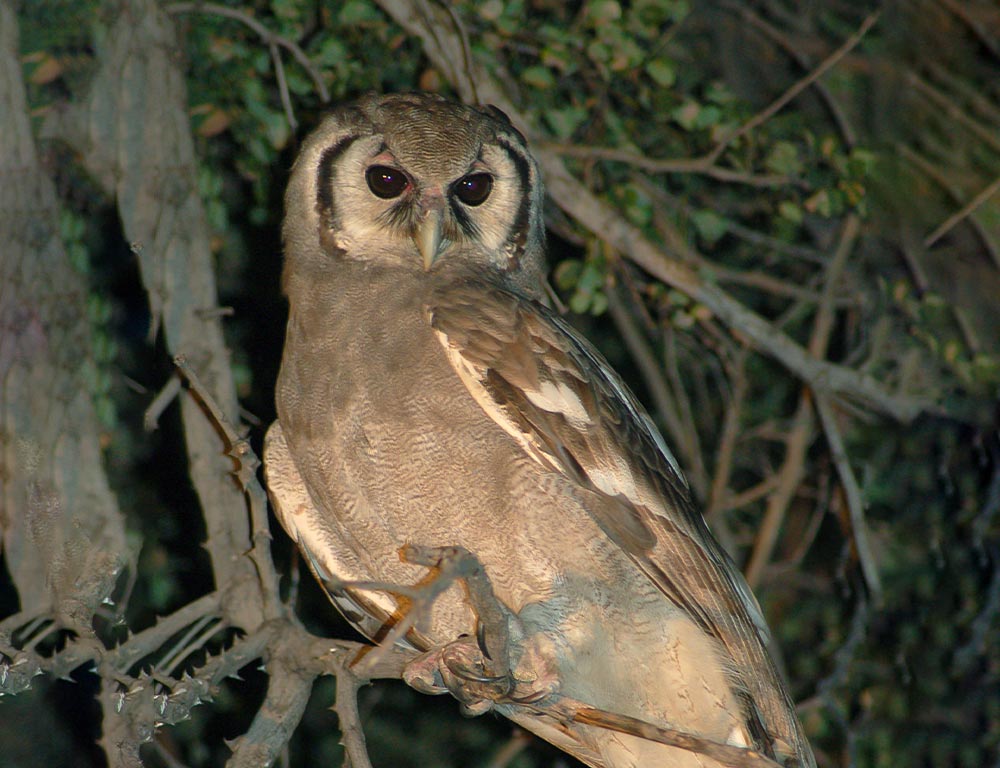
- Scientific name: Bubo lacteus
- Category: Owl
- Life span: Up to 20 years
- Size: 60-66 cm
- Weight: 1.6-2.95 kg
- Food: Carnivorous (small mammals, birds)
- Population: Stable
The Giant Eagle Owl, one of Africa’s largest owl species, is a nocturnal predator with a life span of up to 20 years. They primarily feed on small mammals and birds.
These owls inhabit a range of environments, including savannas and woodlands. With a stable population, they play a vital role in controlling rodent populations.
Conservation efforts focus on maintaining suitable habitats and minimizing potential threats to ensure the continued stability of this impressive and ecologically important owl species.
13. Grey Kestrel

- Scientific name: Falco ardosiaceus
- Category: Bird of Prey
- Life span: Up to 12 years
- Size: 30-35 cm
- Weight: 140-240 g
- Food: Carnivorous (insects, small mammals, birds)
- Population: Stable
The Grey Kestrel, with its distinctive grey plumage, is a small and agile bird of prey. With a life span of up to 12 years, they predominantly feed on insects but also target small mammals and birds.
These kestrels are commonly found in savannas and open woodlands. Their stable population reflects their adaptability to various habitats.
Conservation efforts often focus on ensuring the preservation of suitable nesting sites and maintaining the health of ecosystems where these kestrels thrive.
14. Martial Eagle

- Scientific name: Polemaetus bellicosus
- Category: Bird of Prey
- Life span: Up to 14 years
- Size: 78-96 cm
- Weight: 3.1-6.2 kg
- Food: Carnivorous (birds, mammals, reptiles)
- Population: Decreasing
The Martial Eagle, one of Africa’s largest eagles, is an apex predator with a life span of up to 14 years. They are known for preying on a variety of animals, including birds, mammals, and reptiles.
These eagles inhabit open savannas and wooded areas. Unfortunately, their population is decreasing due to habitat loss, human disturbance, and persecution.
Conservation efforts aim to address these threats, protect nesting sites, and raise awareness to ensure the survival of this formidable and iconic bird of prey.
15. African Scops Owl

- Scientific name: Otus senegalensis
- Category: Owl
- Life span: Up to 10 years
- Size: 19-22 cm
- Weight: 60-170 g
- Food: Carnivorous (insects, small vertebrates)
- Population: Stable
The African Scops Owl, a small nocturnal owl, is known for its camouflaged plumage and haunting calls.
With a life span of up to 10 years, they feed on insects and small vertebrates. These owls are often found in woodland habitats. Despite potential threats like habitat loss, their population remains stable.
Conservation efforts focus on monitoring their populations, understanding their ecological requirements, and preserving the woodlands crucial to their survival.
16. Goshawk

- Scientific name: Accipiter gentilis
- Category: Bird of Prey
- Life span: Up to 15 years
- Size: 46-69 cm
- Weight: 630-1,640 g
- Food: Carnivorous (birds, small mammals)
- Population: Stable
The Goshawk, characterized by its robust build and powerful flight, is a medium to large bird of prey. With a life span of up to 15 years, they primarily feed on birds and small mammals.
Goshawks are adaptable, inhabiting various forested environments. Their stable population highlights their resilience and ability to thrive in diverse habitats.
Conservation efforts often revolve around habitat protection and sustainable forestry practices to ensure the continued stability of this formidable bird of prey.
17. Goshawks
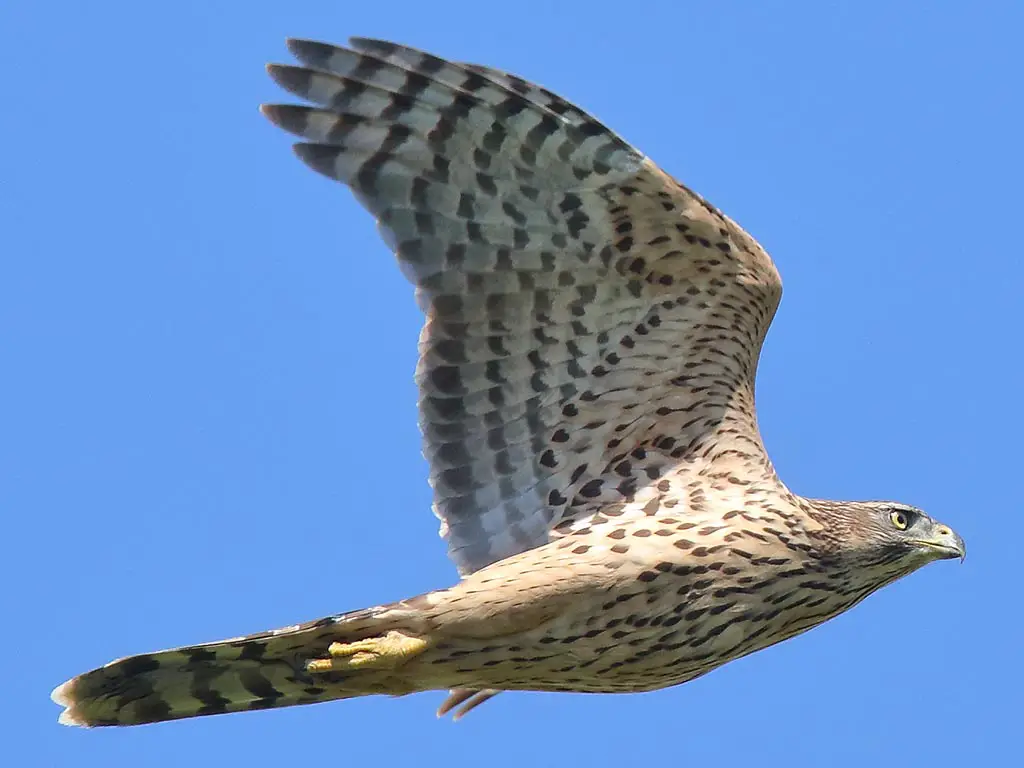
- Goshawk Scientific Name: Accipiter gentilis
- Category: Accipitridae family
- Life Span: Up to 15 years
- Size: 46-69 cm
- Weight: 630-1,640 g
- Food: Carnivorous
- Population: Goshawk: Stable
Goshawks, scientifically known as Accipiter gentilis, are robust and powerful birds of prey with a widespread distribution across various habitats, including forests and woodlands.
With a life span of up to 15 years, they showcase remarkable hunting skills, preying on birds and small mammals. Goshawks are characterized by their short wings and long tails, facilitating agility in flight, and their keen eyesight aids in precise hunting.
These raptors play a vital role in regulating bird and mammal populations, contributing to the overall balance of ecosystems.
Their stable population reflects their adaptability and resilience, although localized declines may occur due to habitat loss and human disturbance.
18. Tawny Eagle

- Scientific Name: Aquila rapax
- Category: Bird of Prey
- Life Span: Up to 16 years
- Size: 62-72 cm
- Weight: 1.6-2.6 kg
- Food: Carnivorous (birds, mammals, reptiles)
- Population: Stable
The Tawny Eagle, a large bird of prey, is a prominent figure in African savannas.
With a life span of up to 16 years, they feed on a diverse diet, including birds, mammals, and reptiles. Tawny Eagles are adaptable and can thrive in various open habitats.
Their stable population underlines their resilience, and they play a crucial ecological role by regulating the populations of their prey.
Conservation efforts focus on preserving their habitats and minimizing potential threats to ensure their continued stability.
19. Buzzards

- Scientific Name: Buteo spp. (e.g., Common Buzzard – Buteo buteo)
- Category: Birds of Prey (Buteonidae family)
- Life Span: Up to 25 years
- Size: 40-58 cm
- Weight: 0.5-1.5 kg
- Food: Carnivorous (small mammals, birds, insects)
- Population: Varies among species
Buzzards, belonging to the Buteonidae family, are medium-sized birds of prey. The Common Buzzard, for instance, has a life span of up to 25 years.
They display a varied diet, including small mammals, birds, and insects. Buzzards are adaptable and inhabit diverse environments, from woodlands to open fields.
Their populations vary among species, with some facing threats from habitat loss and poisoning. Conservation efforts aim to protect their habitats and mitigate potential risks to ensure the well-being of these versatile raptors.
20. True Eagles
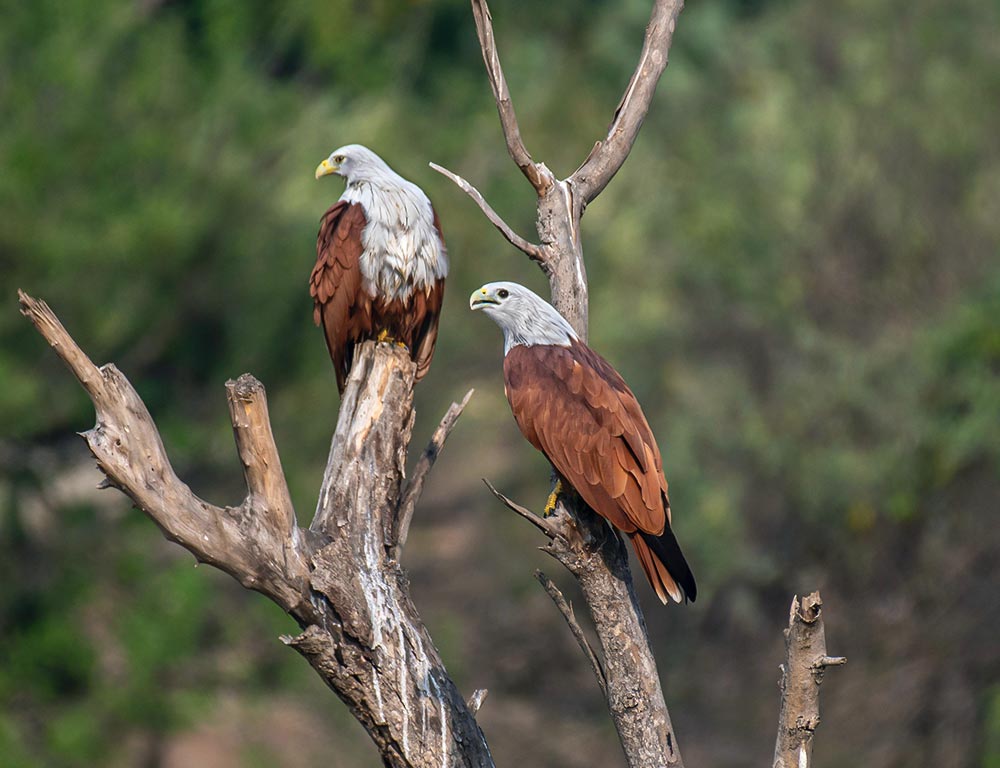
- Scientific Name: Aquila spp. (e.g., Golden Eagle – Aquila chrysaetos)
- Category: Birds of Prey (Accipitridae family)
- Life Span: Up to 30 years
- Size: Varies among species (e.g., Golden Eagle: 66-102 cm)
- Weight: Varies among species (e.g., Golden Eagle: 2.8-6.7 kg)
- Food: Carnivorous (birds, mammals, reptiles)
- Population: Varies among species
True Eagles, including the iconic Golden Eagle, are large and powerful birds of prey within the Accipitridae family. With life spans of up to 30 years, they are apex predators, feeding on birds, mammals, and reptiles.
True Eagles inhabit diverse landscapes, from mountains to open plains. Their populations vary among species, with some facing threats like habitat loss and human disturbance.
Conservation efforts focus on protecting nesting sites and minimizing potential hazards to ensure the survival of these majestic raptors.
21. Hawk-Eagle
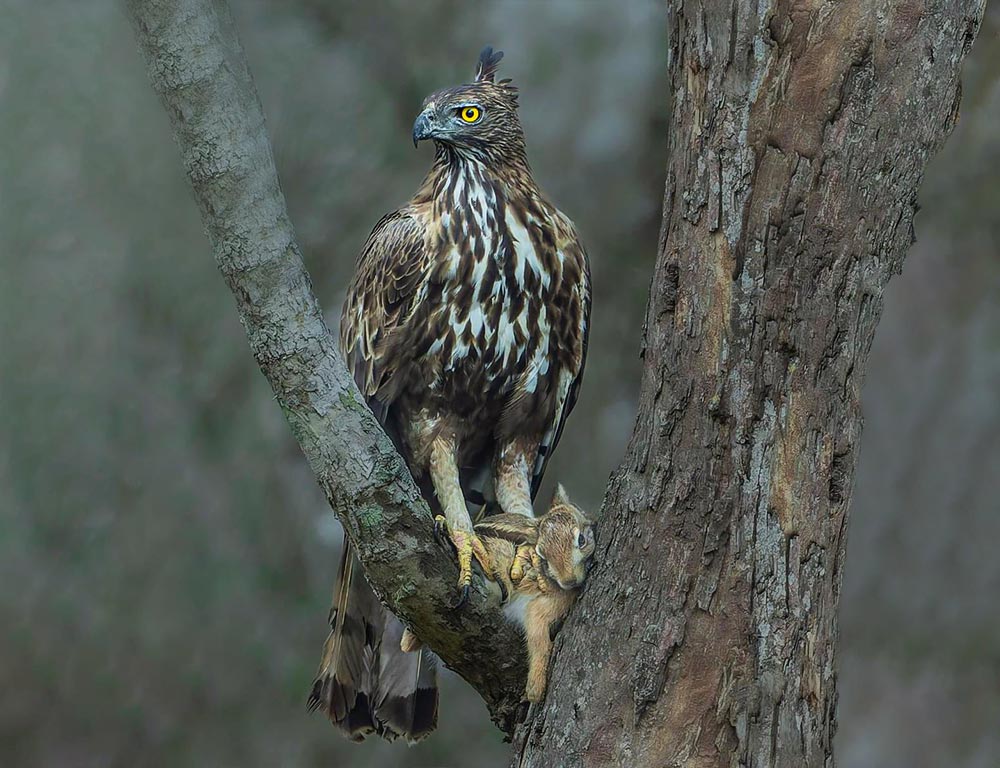
- Scientific Name: Spizaetus spp
- Category: Bird of Prey
- Life Span: Up to 20 years
- Size: 51-69 cm
- Weight: 1.2-2.3 kg
- Food: Carnivorous
- Population: Varies among species
Hawk-eagles, exemplified by species like the Changeable Hawk-Eagle, are formidable birds of prey.
With life spans of up to 20 years, they primarily feed on birds and small mammals. Hawk eagles are known for their powerful talons and agile flight, often hunting in forested areas.
Their populations vary among species, and conservation efforts focus on understanding their specific habitat requirements to ensure their continued presence in diverse ecosystems.
22. Vultures

- Scientific Name: Gyps Africanus
- Category: Bird of Prey
- Life Span: Up to 30 years
- Size: 78-98 cm
- Weight: 3-8 kg
- Food: Carrion
- Population: Declining
Vultures play a critical role as nature’s cleanup crew, scavenging on carrion. Various species, such as the White-backed Vulture, contribute to ecosystem balance.
With varying life spans and sizes, vultures face population declines due to factors like habitat loss, poisoning, and collisions with power lines.
Conservation efforts aim to address these threats, establish safe feeding sites, and raise awareness about the ecological importance of vultures.
23. Dark Chanting Goshawk

- Scientific Name: Melierax metabates
- Category: Bird of Prey
- Life Span: Up to 15 years
- Size: 55-65 cm
- Weight: 450-800 g
- Food: Carnivorous (birds, small mammals)
- Population: Stable
The Dark Chanting Goshawk, a medium-sized raptor, is a resident of African savannas. With a life span of up to 15 years, they predominantly feed on birds and small mammals.
These goshawks are known for their aerial agility and adept hunting skills. Their stable population reflects their adaptability to various habitats, from grasslands to open woodlands.
Conservation efforts often involve monitoring their populations and ensuring the preservation of habitats crucial for their survival.
24. Egyptian Vulture

- Scientific Name: Neophron percnopterus
- Category: Bird of Prey
- Life Span: Up to 21 years
- Size: 50-67 cm
- Weight: 1.6-2.8 kg
- Food: Carrion, insects
- Population: Declining
The Egyptian Vulture, with its distinct appearance and dietary habits, is a scavenger that also consumes insects.
With a life span of up to 21 years, they face population declines due to factors like poisoning, habitat loss, and reduced food availability.
Conservation efforts focus on mitigating threats, providing supplementary food, and raising awareness to ensure the survival of this unique and declining vulture species.
25. Sparrowhawks

- Scientific Name: Accipiter nisus
- Category: Bird of Prey
- Life Span: Up to 9 years
- Size: 29-34 cm
- Weight: 150-340 g
- Food: Carnivorous (small birds, occasionally small mammals)
- Population: Increasing
Sparrowhawks, scientifically known as Accipiter nisus, are small and agile birds of prey found in various habitats, including woodlands, gardens, and urban areas.
With a life span of up to 9 years, they exhibit exceptional flying skills and rapid maneuvering, making them adept hunters of small birds. Their diet primarily consists of songbirds, and occasionally, they target small mammals.
These raptors have experienced an increasing population, reflecting successful conservation efforts and adaptation to human-altered landscapes.
Sparrowhawks play a crucial role in regulating bird populations, helping to maintain a balance in local ecosystems. Their presence in diverse environments showcases their adaptability, making them a fascinating and resilient species within the avian world.
Conservation initiatives often focus on monitoring their populations, understanding their interactions with human activities, and ensuring the preservation of suitable habitats for these dynamic birds of prey.
Wrapping Up
These aerial predators, from the iconic African Fish Eagle to the stealthy Martial Eagle, epitomize the continent’s diverse ecosystems.
Each species, with its unique hunting techniques and adaptations, weaves a narrative of survival and significance in maintaining ecological balance.
As we marvel at the formidable wingspans and keen eyesight, we recognize the crucial roles these raptors play in shaping the African wilderness.
The enchanting symphony of aerial prowess and natural symbiosis creates a vibrant tapestry that demands appreciation and conservation.
Understanding the importance of these majestic birds not only elevates our appreciation for African biodiversity but also underscores the urgency of preserving their habitats.
As stewards of our shared planet, it is our collective responsibility to ensure the skies of Africa continue to echo with the graceful flight and predatory prowess of its awe-inspiring Birds of Prey.